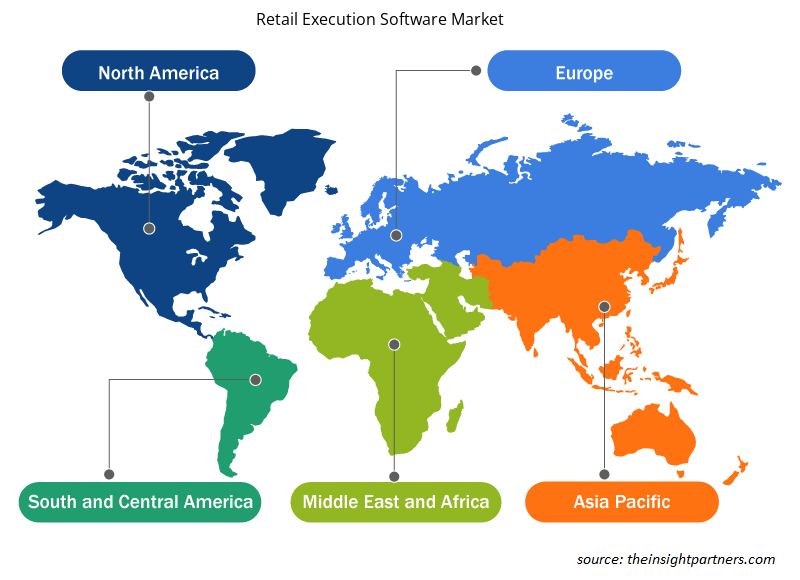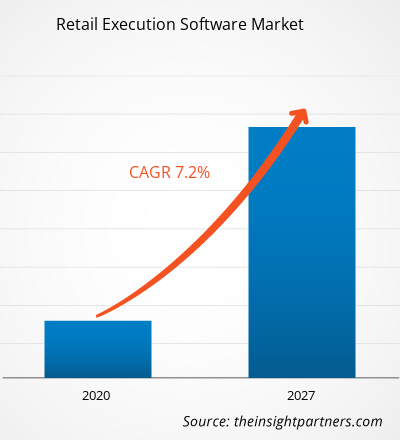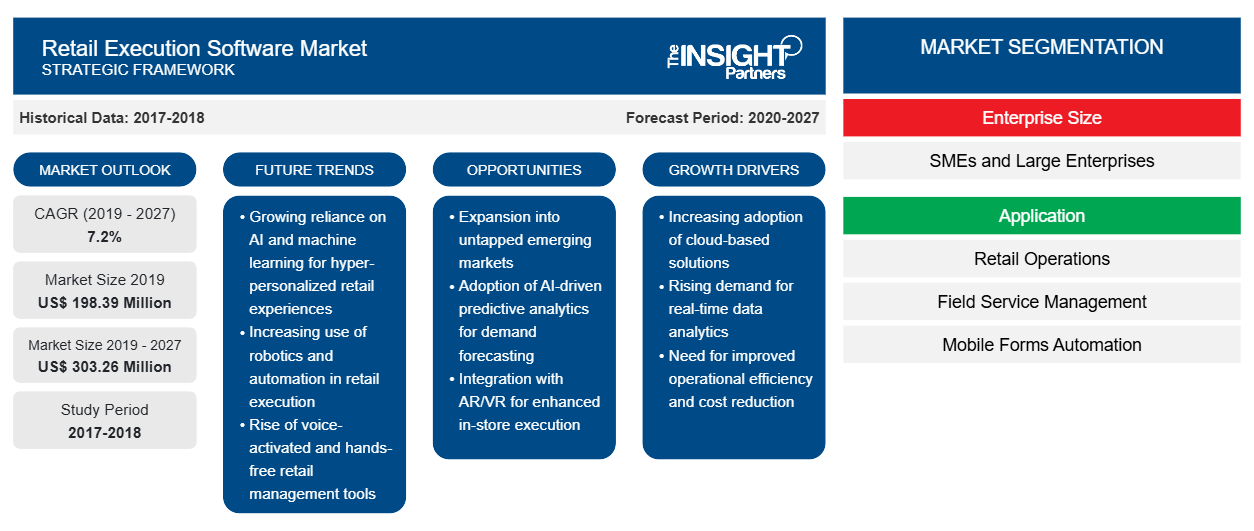2019 年零售执行软件市场价值为 1.9839 亿美元,预计到 2027 年将达到 3.0326 亿美元;预计 2020 年至 2027 年的复合年增长率为 7.2%。
由于零售和电子商务平台的偏好日益增加,以及支付网关与零售执行软件的日益融合,全球零售执行软件市场正在经历大幅增长。从地域上看,北美以 31.13% 的收入份额领先市场,其次是欧洲和亚太地区。快速增长的经济、自动化技术的日益普及、互联网的日益普及以及终端用户对软件的大量采用是推动这些地区零售执行软件市场增长的主要因素。预计亚太地区的零售执行软件市场在预测期内将以最高的复合年增长率增长。零售行业越来越多地采用先进技术推动了零售执行软件的采用率。公司投资软件以简化其业务运营。在亚太地区,零售和电子商务增长最快的市场是印度和中国。由于互联网普及率的提高,这些国家的消费者非常倾向于网上购物,网上购物趋势正在改变该地区零售和电子商务的多个领域。因此,这些因素正在推动亚太地区零售执行软件市场的增长。由于政府不断加大力度采用先进技术实现经济数字化,预计中东和非洲及南美等其他发展中地区也将保持稳步增长。
定制此报告以满足您的需求
您可以免费定制任何报告,包括本报告的部分内容、国家级分析、Excel 数据包,以及为初创企业和大学提供优惠和折扣
-
获取此报告的关键市场趋势。这个免费样品将包括数据分析,从市场趋势到估计和预测。
COVID-19 疫情对零售执行软件市场的影响
根据世界卫生组织 (WHO) 的最新报告,美国、西班牙、意大利、法国、德国、英国、俄罗斯、土耳其、巴西、伊朗和中国是受 COVID-19 疫情影响最严重的国家。这场危机对全球各行各业产生了不利影响。全球经济在 2020 年受到的打击最为严重,而且这种情况很可能在 2021 年持续下去。疫情对物流、零售和电子商务等主要行业造成了严重破坏。国际物流业务行业的急剧下滑正在抑制全球零售执行软件市场的增长。
零售执行软件市场洞察
提高支付网关与零售执行软件的集成度
推动零售执行软件市场的增长
在线支付在亚太地区相对流行,因为大多数消费者使用手机支付商品。在韩国、日本、新加坡和澳大利亚等国家,有几种流行的电子支付方式用于移动数字购物。这些国家的支付网关公司正在向各种零售执行软件提供商提供全面的电子支付解决方案,以赶上技术发展的浪潮。此外,市场增长归因于支付网关技术的进步和移动钱包使用的增加。支付网关系统与零售执行软件的日益融合、在线购物的兴起,加上计费方法的进步,预计将在预测期内进一步推动对零售执行软件的需求。
基于企业规模的市场洞察
根据企业规模,零售执行软件市场分为大型企业和中小型企业。2019 年,大型企业占据了相当大的市场份额。然而,预计中小型企业在预测期内将实现显著的复合年增长率。
基于应用的市场洞察
根据应用,零售执行软件市场细分为零售运营、现场服务管理、移动表单自动化、现场销售、贸易促销管理、员工参与等。2019 年,零售运营部门占据了市场相当大的份额。零售运营涉及个人管理、供应链、商店布局、现金运营、实物库存以及主数据、促销和定价管理。零售运营的零售执行软件为实体零售店提供了工具,以利用其当前信息并以有利于其业务的方式利用这些信息。
公司积极开发新产品,以在零售执行软件市场获得吸引力。例如,Salesforce 推出了一款新的行业产品,即 Consumer Goods Cloud,它允许消费品公司通过增强零售执行能力来促进收入增长并提高投资回报率。以下列出了一些主要参与者的进展:
2020 年:StayinFront, Inc. 零售数据洞察 (RDI) 扩大了与 Field Sales Solutions 的合作伙伴关系,以实现实时分析。StayinFront RDI 的现场视图和 ROI 视图为现场销售团队提供了可操作的洞察。这些服务促进并最大化店内效率,使 Field Sales Solutions 的客户能够做更多、了解更多和销售更多。2018
年:Intelligence Retail 与 IBM 接洽,以增强其主要产品,并允许其客户利用实时跟踪关键商店审计指标的优势。Intelligence Retail 解决方案的新分析模块基于嵌入式 IBM Watson Analytics 技术,旨在通过实时处理大数据来帮助有效跟踪零售审计的关键指标,包括货架上商品的可用性、货架份额、价格和促销活动
零售执行软件市场区域洞察
Insight Partners 的分析师已详尽解释了预测期内影响零售执行软件市场的区域趋势和因素。本节还讨论了北美、欧洲、亚太地区、中东和非洲以及南美和中美洲的零售执行软件市场细分和地理位置。

- 获取零售执行软件市场的区域特定数据
零售执行软件市场报告范围
| 报告属性 | 细节 |
|---|---|
| 2019 年市场规模 | 1.9839亿美元 |
| 2027 年市场规模 | 3.0326亿美元 |
| 全球复合年增长率(2019 - 2027) | 7.2% |
| 史料 | 2017-2018 |
| 预测期 | 2020-2027 |
| 涵盖的领域 |
按企业规模
|
| 覆盖地区和国家 |
北美
|
| 市场领导者和主要公司简介 |
|
零售执行软件市场参与者密度:了解其对业务动态的影响
零售执行软件市场正在快速增长,这得益于最终用户需求的不断增长,而这些需求又源于消费者偏好的不断变化、技术进步以及对产品优势的认识不断提高等因素。随着需求的增加,企业正在扩大其产品范围,进行创新以满足消费者的需求,并利用新兴趋势,从而进一步推动市场增长。
市场参与者密度是指在特定市场或行业内运营的企业或公司的分布情况。它表明相对于给定市场空间的规模或总市场价值,有多少竞争对手(市场参与者)存在于该市场空间中。
在零售执行软件市场运营的主要公司有:
- Bizom(Mobisy 技术私人有限公司)
- EdgeCG(StayinFront 公司)、
- 智能零售
- 摩比软件
- POPProbe
免责声明:上面列出的公司没有按照任何特定顺序排列。

- 获取零售执行软件市场顶级关键参与者概述
按企业规模
- 大型企业
- 中小企业
按应用
- 零售业务
- 现场服务管理
- 移动表单自动化
- 现场销售
- 贸易促销管理
- 员工敬业度
- 其他的
按地理位置
-
北美
- 我们
- 加拿大
- 墨西哥
-
欧洲
- 法国
- 德国
- 意大利
- 英国
- 俄罗斯
- 欧洲其他地区
-
亚太地区 (APAC)
- 中国
- 印度
- 韩国
- 日本
- 澳大利亚
- 亚太地区其他地区
-
中东和非洲 (MEA)
- 南非
- 沙特阿拉伯
- 阿联酋
- MEA 其他地区
-
南美洲 (SAM)
- 巴西
- 阿根廷
- SAM 其余部分
公司简介
- Bizom(Mobisy 技术私人有限公司)
- EdgeCG(StayinFront,Inc.)
- 智能零售
- 摩比软件
- POPProbe
- Spring Mobile Solutions, Inc.
- Trax 技术解决方案私人有限公司
- 瓦洛米尼亚
- 威尼特
- 凯度集团
- 历史分析(2 年)、基准年、预测(7 年)及复合年增长率
- PEST和SWOT分析
- 市场规模、价值/数量 - 全球、区域、国家
- 行业和竞争格局
- Excel 数据集
近期报告
相关报告
客户评价
购买理由
- 明智的决策
- 了解市场动态
- 竞争分析
- 客户洞察
- 市场预测
- 风险规避
- 战略规划
- 投资论证
- 识别新兴市场
- 优化营销策略
- 提升运营效率
- 顺应监管趋势























 获取免费样品 - 零售执行软件市场
获取免费样品 - 零售执行软件市场